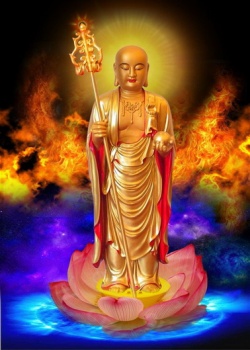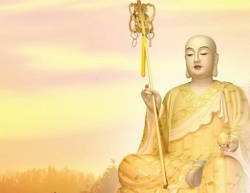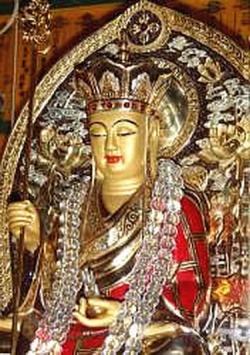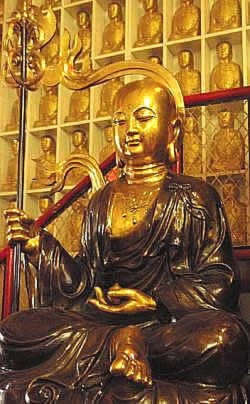Why Buddha Touched the Earth
There's one character in Japanese Buddhism who is seen perhaps more frequently than Daruma (Bodhidhama) or Kannon (the Japanese name for Kuan Yin) -- maybe even more than the Buddha himself, depending on how you count. His name is Jizo, and he is a special guardian of children (and therefore also of expectant or hopeful mothers), and of firefighters. He is also a protector of travellers, and because of this Jizo statues are often found along the road, out in the open rather than cooped up in temples. It's helped make him very accessible deity.
Jizo watches over those travelling not just earthly roads, but all the paths through the six realms of existence, especially in hell realms.
The idea of hells doesn't seem to be part of the Buddha's original teachings. While he used the Hindu concept of re-incarnation as a teaching tool, the Buddha didn't have much to say about the afterlife: it wasn't relevant or helpful to his goal of relieving human suffering. And notions of an afterlife don't mesh all that well with the ideas of anatman and sunyatta, "no-self" and "emptiness". If the "self" is an illusion, if "I" am a character in the story my mind is telling, what is there to live on in a heaven or to be reborn?
But Mahayana Buddhism never met an idea, myth, or metaphor that it didn't like. In the centuries after the Buddha's death, Mahayana teachers and adherents began to include and adapt their culture's notions of reincarnation into higher and lower realms. After a while, the view evolved that there were six paths of reincarnation to which a person might be subjected. One might be reborn in the pleasure realms of the gods, or as a "titan" (or "wrathful demigod"), as a human, as an animal, as a "hungry ghost", or into a hell realm. But none of these are permanent. The pleasure realms are a stagnating gilded cage that eventually breaks open, the hells a temporary sentence.
Jizo's great vow is that he will not enter Nirvana so long as any being is in hell -- an "I am not free so long as any man is enslaved" sort of sentiment. He descends into the hell realms to aid and comfort the dammed. In the mythology of Mahayana Buddhism, no sentient being will be thrown away, no one is left behind. With bodhisattvas like Jizo guiding us, we all make it to enlightenment, though it might take billions of years. It's a lovely thought.
Jizo's association with firefighters stems fairly straightforwardly with his mission to descend into hell realms. It's more surprising that his connection with children does also, via a myth about the fate in the afterlife of children who die young. According to the legend, the children are stuck on the banks of the river Sai, a sort of Buddhist version of the the river Styx that the dead must cross over. Since they died young, they had no opportunity to accumulate enough merit ("good karma") to move on, and so they are condemned to stay on the riverbank and pile up stones to build little stupas, which are knocked down by demons every evening. Only Jizo offers them protection and aid.
Because of this association with children who have died, there is a common memorial ritual of clothing Jizo statues in bibs or in other child's clothes, or of leaving toys or other items with a statue. Seeing these offerings at roadside Jizo shines has moved me to tears more than once.
Jizo is not an invention of Japanese Buddhism; he goes all the way back to India, where she was known as Kshitigarbha. No, that's not a typo, a gender change occurred during her/his migration. It's not unprecedented: the male bodhisattva Avalokiteshvara became the goddess Kuan Yin in China. Kshitigarbha was definitely female, while Jizo is mostly -- but not exclusively -- portrayed as male.
But Jizo never made as much of a splash in Buddhist countries on the Asian mainland as he/she did here. So I hadn't heard of Jizo until my first visit to Japan. And even then, all I learned was that he was a Buddhist figure seen as a guardian of children.
My ignorance turned out to be ironic.
For about 15 years, I've had a Buddhist wall hanging that I bought from a vendor in the parking lot at a Grateful Dead show. I was told at the time that the Chinese characters in an upper corner read "Earth Buddha".
As someone interested in both Buddhism and in earth-oriented Pagan religion, I thought that was pretty cool. This "Earth Buddha" was my first hint that there might be some deeper connection between Paganism and Buddhism.
When I had managed to teach myself a tiny bit about kanji, I tried looking up the characters that label this painting. Four characters: the first is indeed "earth", the last two were "bodhisattva" (or "bosatsu" in their Japanese reading). The second character, though, I couldn't quite figure out. Still, "earth (mumble) bodhisattva" was good enough.
There my knowledge stopped for a few years. But during a visit to the National Museum in Nara, I found a few Jizo statues on display. The exhibit mentioned Jizo's role as a guardian of travellers, and being a traveller far from home I set out to learn more about him.
I was particularly struck when I read that he is portrayed carrying a monk's staff, which he uses to pry open the gates of hell, and a gem that lights the way. Hey, I thought, the "Earth Buddha" in my painting has a staff and a gem...
Then I took a look at the kanji for his name. It turns out Jizo Bosatsu means "Earth-Store" or "Earth-Womb" Bodhisattva. Yep, I'd had Jizo hanging on my wall all these years and not known it. (The depiction that I have is more of a Chinese or perhaps Korean style, so I don't feel too bad for not recognizing him/her right away in Japan.)
If the Earth Store Bodhisattva was just a Buddhist earth spirit who protected the vulnerable, he/she would already be of interest to Pagans. But the story goes deeper.
According to the legendary accounts of the Buddha's enlightenment, as he sat in meditation, he was challenged by the demon Mara, the lord of illusion. Mara tried tempting and threatening the Buddha, and when that failed tried pressing a claim that the accolades of his army showed that he was more entitled to be a spiritual leader than the solitary Buddha.
Here's how Paul Carus summarizes the story:
Mara caused a whirlwind to blow, but in vain; he caused a rain-storm to come in order to drown the Buddha, but not a drop wetted his robes; he caused a shower of rocks to come down, but the rocks changed into bouquets; he caused a shower of weapons--swords, spears, and arrows--to rush against him, but they became celestial flowers; he caused a shower of live coals to come down from the sky, but they, too, fell down harmless. In the same way hot ashes, a shower of sand, and a shower of mud were transmuted into celestial ointments. At last he caused a darkness, but the darkness disappeared before Buddha, as the night vanishes before the sun. Mara shouted: "Siddhattha, arise from the seat. It does not belong to you. It belongs to me." Buddha replied: "Mara, you have not fulfilled the ten perfections. This seat does not belong to you, but to me, who have fulfilled the ten perfections." Mara denied Buddha's assertion and called upon his army as witnesses, while Buddha declared: "I have no animate witnesses present;" but, stretching out his right hand towards the mighty earth, he said: "Will you bear me witness?" And the mighty earth thundered: "I bear you witness." And Mara's elephant fell upon its knees, and all the followers of Mara fled away in all directions. When the hosts of the gods saw the army of Mara flee, they cried out: "Mara is defeated! Prince Siddhattha has conquered! Let us celebrate the victory!"
This moment is a favorite subject of Buddhist art. Many sculptures and paintings depict the Buddha reaching down to touch and invoke the earth.
In Carus's version, the Buddha's witness is merely "the earth," without personification. But in other versions of the tale, the earth is represented by Prithivi, the goddess of the Earth. In the Lalitavistara, for example, the story goes that she rose up halfway out of the ground and testified to the purity of the Buddha.
Prithivi is an ancient goddess, long pre-dating Buddhism: she's mentioned in the Rig Veda, one of the oldest extant religious texts. She is the "Womb of the World", the "Source of Everything", the "All Nourishing" "Mother of Plants". She is also proof against lies, "founded on truth" and cannot be deceived. Certainly a good witness to have on your side.
Some scholars believe that the bodhisattva Kshitigarbha developed out of Prithivi. And in the account of early Buddhist scholar Samuel Beal, it was Kshitigarbha who testified for the Buddha.
Let's ponder this for a moment. According to the mythology of Mahayana Buddhism, the Buddha's spiritual authority derives from an Earth deity. An earth goddess, no less.
If we consider the connection between earth religions and agriculture, then it is not surprising and not by chance that the mythical biographies also have the young Buddha first experiencing a state of meditation while watching the rituals of the spring plowing .
Compare this connection to the earth with the Abrahamic religions which we more commonly encounter. Jesus, Moses, and Mohammad all claimed the authority of the sky god (the "god of heaven"), Jehovah. Even in the classic Greco-Roman pantheon, the chief of the gods is thunderbolt-hurling sky god Zeus/Jupiter. All sky religions, patriarchal and hierarchical.
But Buddhism is -- at least by this bit of mythology -- an earth religion! When challenged, when in doubt, the Buddha did not appeal to a higher power, but reached down for support.
But perhaps we're reading too much supernaturalism into it.
Another interpretation of the Buddha's touching the earth was suggested to me by my good friend Eric Wiegmann, who spent several years living as a monk in a Tibetan Buddhist tradition. As he discovered, after long periods of meditation it's quite possible to become both mentally disoriented and physically dizzy. Can we imagine that Sidhartha was lightheaded, and just reached down to steady himself?
The comedian Steven Wright, known for expressing a wonderfully quirky off-center point of view, has a bit that goes "You know how it feels when you're leaning back on a chair, and you lean too far back, and you almost fall over backwards, but then you catch yourself at the last second? I feel like that all the time." What if that's how the Buddha felt?
Meditation practitioners can fall over -- and not just physically. If you don't catch yourself it's possible to become detached and withdrawn, to lose track of your connection with the world. And then rather than being a way of cutting through illusion, meditation becomes something else to become attached to. The contemporary Zen master Seung Sahn wrote, "So much sufferings [sic] in Nirvana castles. So joyous to sink into this world."
The famous Beatles song "Dear Prudence" is based on such an incident, or at least what John Lennon, that old Zen Pagan, perceived to be one. Prudence Farrow, sister of the famous actress Mia Farrow, was training with the Maharishi Mahesh Yogi at the same time that the Beatles were. Farrow stayed secluded in her room meditating all the time, rather than interacting with the other students. In Lennon's words,
All the people around her were very worried because she was going insane, So we sang to her.
They selected me and George to try and bring her out because she would trust us. She went completely mental. If she'd been in the West they would have put her away. We got her out of the house. She'd been locked in for three weeks and wouldn't come out, trying to reach God quicker than anybody else. That was the competition in Maharishi's camp: who was going to get cosmic first. (What I didn't know was I was already cosmic.)
To use an analogy, one of the greatest dangers that pilots of small aircraft face is getting lost in the clouds such that they lose track of which direction the ground lies. Could it be that as he sat under the Bo tree, Siddhartha was lost, in mental space rather than airspace, and put his hand down to the ground to re-orient himself?
In that moment, moving from total confusion to feeling the ground under him, he might have experienced an instant of the clarity that Zen calls "mushin", "no mind". Joseph Campbell explains this "no mind" as follows:
[W]e might say that when a situation or phenomenon evokes in us a sense of existence (instead of some reference to the possibility of a assurance of meaning) we have had an experience of this kind. The sense of existence evoked may be shallow or profound, more or less intense, according to our capacity or readiness; but even a brief shock (say, for example, when discovering the moon over city roofs or hearing a sharp bird cry at night) can yield an experience of the order of no-mind: that is to say, the poetical order, the order of art. When this occurs, our own reality-beyond-meaning is awakened (or perhaps better: we are awakened to our own reality-beyond-meaning)...One moment later, and we have classified the experience, and may be having utterable thoughts and describable feelings about it -- thoughts and feelings that are in the public domain, and they will be either sentimental or profound, according to our education. But according to our life, we have had, for an instant, a sense of existence: a moment of unevaluated, unimpeded, lyric life -- antecedent to both thought and feeling; such as never can be communicated by means of empirically verifiable propositions, but only suggested by art.
Imagine it this way: Siddhartha, dizzy and confused, even despairing a little bit. He's consulted the best spiritual teachers around, to no avail. He's starting to wonder if he's completely off-track. He's pushed his body to the limit, almost died, with nothing to show for it, and he's still recovering from that bad idea. With nothing else to go on, he meditates and meditates and meditates until he's chased himself in circles.
He starts to lose it. He puts his hand down to steady himself. He feels the ground, the earth, the cool rich living soil under his hand, always supporting him and all beings, giving him orientation. Ah! Down is down, up is up. You can't fall off the earth. Nothing to fear. Here I am. So simple. Ah!
Ah!
Let us then consider Jizo, Kstigarba, Prithvi, the earth spirit by whatever name, as a personification of that moment of clarity, grounding away all delusion and self-doubt. Like an electrical circuit, a spiritual seeker must be well grounded.
Source
Why Buddha Touched the Earth
Zen Paganism for the 21st Century
by Tom Swiss






